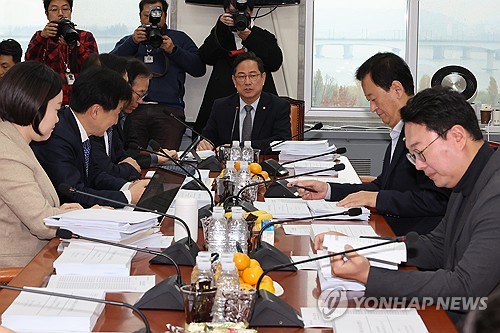(Seoul=Yonhap Infomax) Nam Kyoung Hwang – South Korea’s National Assembly Strategy and Finance Committee has begun in-depth discussions on introducing a separate taxation regime for dividend income as part of the country’s tax reform package, with the top marginal tax rate emerging as the main point of contention.
Lawmakers are moving closer to lowering the top rate from the government’s proposed 35% to 25%, though some members continue to express reservations, indicating further negotiations will be required before a final decision is reached.
The committee’s tax subcommittee convened on the morning of the 25th to formally begin deliberations on the separate taxation of dividend income.
Park Soo-young, the subcommittee chair and a member of the ruling People Power Party, told reporters after the session was adjourned, “There are 12 bills on the table, and while the differences are significant, we have had thorough discussions with both government officials and lawmakers. We need to further discuss how to consolidate these into a consensus proposal.”
He added, “Both lawmakers advocating for a lower tax rate and the government have shown willingness to accept a reduction, but there are also members who are firmly opposed. We have not reached a complete agreement. However, since the subcommittee traditionally decides by consensus rather than majority vote, we will continue discussions.”
On the level of the top tax rate, Park said, “The majority view is in favor of a 25% rate, though there are about two members who oppose it. We will continue to deliberate.”
Lee So-young, a lawmaker from the main opposition Democratic Party, also told reporters, “The government indicated today, as it has previously, that it is open to lowering the top rate from the originally proposed 35%. The general direction is moving toward a reduction from the government’s initial proposal.”
The timing for the introduction of separate dividend taxation appears to have been settled. Lee had previously stated on Facebook that the new regime should be applied to dividend payments for the April 2026 fiscal year, one year ahead of the government’s plan.
“I believe the issue of timing has been largely resolved,” Lee said. “The government has also shown a more flexible stance on several remaining details.”
However, the eligibility criteria for separate taxation remain under discussion. Lee explained, “My proposal only includes an excellence award, not an effort award, so it’s difficult to compare directly with the government’s plan. It would be good to carefully assess which approach better incentivizes higher dividends.”
She continued, “The effort award itself is meaningful. However, as I pointed out during the National Assembly audit, the provision requiring a 5% increase over the three-year average could result in a discount effect. The government acknowledged the validity of this point and is likely to revise the relevant clauses.”
The government’s initial proposal stipulated that companies would qualify for separate dividend taxation if their payout ratio was at least 40%, or at least 25% with a dividend increase of 5% or more compared to the average of the past three years.
However, critics argue that most listed companies would meet the 25% payout and 5% increase criteria simply by raising dividends in line with inflation, thus failing to provide a meaningful incentive for higher payouts.
Park Soo-young also noted, “The government’s plan divides the system into an excellence award and an encouragement award. There are opinions that these should be separated or that the requirements should be eliminated altogether. The gap is wide, so it’s unclear how consensus will be reached, but we will continue to coordinate.”
*

nkhwang@yna.co.kr
(End)
Copyright © Yonhap Infomax Unauthorized reproduction and redistribution prohibited.

